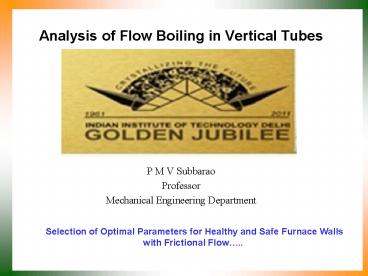Analysis of Flow Boiling in Vertical Tubes PowerPoint PPT Presentation
1 / 18
Title: Analysis of Flow Boiling in Vertical Tubes
1
Analysis of Flow Boiling in Vertical Tubes
- P M V Subbarao
- Professor
- Mechanical Engineering Department
Selection of Optimal Parameters for Healthy and
Safe Furnace Walls with Frictional Flow..
2
Flow Boiling
- Flow boiling occurs when all the phases are in
bulk flow together in a channel - e.g., vapor and liquid flow in a pipe.
- The multiphase flow may be classified as
adiabatic or diabatic, i.e., without or with heat
addition at the channel wall. - Void fraction and Pressure drop are two important
parameters in real flow boiling.
3
Adiabatic Flow Through A Pipe
4
Diabatic Flow Through A Pipe
5
Selection of Flow rate in Flow Boiling
- This process may either be forced convection or
gravity driven. - At relatively low flow rates at sufficient wall
superheats, bubble nucleation at the wall occurs
such that nucleate boiling is present within the
liquid film. - At high qualities and mass flow rates, the flow
regime is normally annular. - As the flow velocity increases, convection in the
liquid film is augmented. - The wall is cooled below the minimum wall
superheat necessary to sustain nucleation. - Nucleate boiling may thus be suppressed, in which
case heat transfer is only by convection through
the liquid film and evaporation occurs only at
its interface.
6
Pressure drop Religious to Secular Attitude
Dphydro Dpfriction
Dphydro Dpfriction
7
Pressure Drop in Tubes
- The pressure drop through a tube comprise several
components friciton, entrance loss, exit loss,
fitting loss and hydrostatic.
Exact prediction of wall temperature, it is
important to know the pressure Variation along
the flow
8
Circulation Vs Once Through
9
(No Transcript)
10
(No Transcript)
11
(No Transcript)
12
Auto Control Mechanism in Natural Circulation
13
Selection of Steam Mass Flow rate
- A once-through forced circulation furnace with
high mass flow - If any tube receives more heat than the average,
then it will accept receives less flow. - This can result in further increasing
temperatures, potentially leading to failures. - Thus the mass flow per tube must start very high
to ensure adequate remaining flow after the heat
upsets. - Designs with medium mass flow
- These were attempted in once through forced
circulation boilers with moderate success. - These exhibit worse consequences than the high
mass flow designs. - When the mass flow is degraded during load
reduction in a tube receiving more heat than the
average, the remaining flow will have less margin
to provide acceptable cooling. - Medium mass flow designs can experience heat
upsets and/or flow excursions that result in
flows in individual tubes that are lower than the
low mass flow design.
14
Destructive Mechanisms in Forced Circulation/Onec
through
15
(No Transcript)
16
(No Transcript)
17
- Both the multi-pass and the spiral designs use
high fluid mass flows. - High fluid mass flow rates result in high
pressure losses as well as a once-through . - Means that strongly heated tubes have a reduction
in fluid mass flow and a correspondingly high
increase in fluid and therefore metal temperature
which can result in excessive tube-to-tube
temperature differentials. - This type of behavior is sometimes referred to as
a "negative flow characteristic. - In the Vertical design, the furnace enclosure is
formed from a single, upflow pass of vertical
tubes.
18
- The tube size and spacing is selected to provide
a low fluid mass flow rate of approximately 1000
kg/m2-s or less. - With low mass flow rates, the frictional pressure
loss is low compared to the gravitational head,
and as a result, a tube that is heated strongly,
i.e., absorbs more heat, draws more flow. - With an increase in flow to the strongly heated
tube, the temperature rise at the outlet of the
tube is reduced which limits the differential
temperature between adjacent tubes. - This is known as the "natural circulation or
"positive flow" characteristic. - Minimize peak tube metal temperatures.
- To minimize peak tube metal temperatures,
multiple pass and spiral types designs use high
fluid mass flow rates to achieve good tube
cooling. - This results in the "once-through characteristic
noted above.

